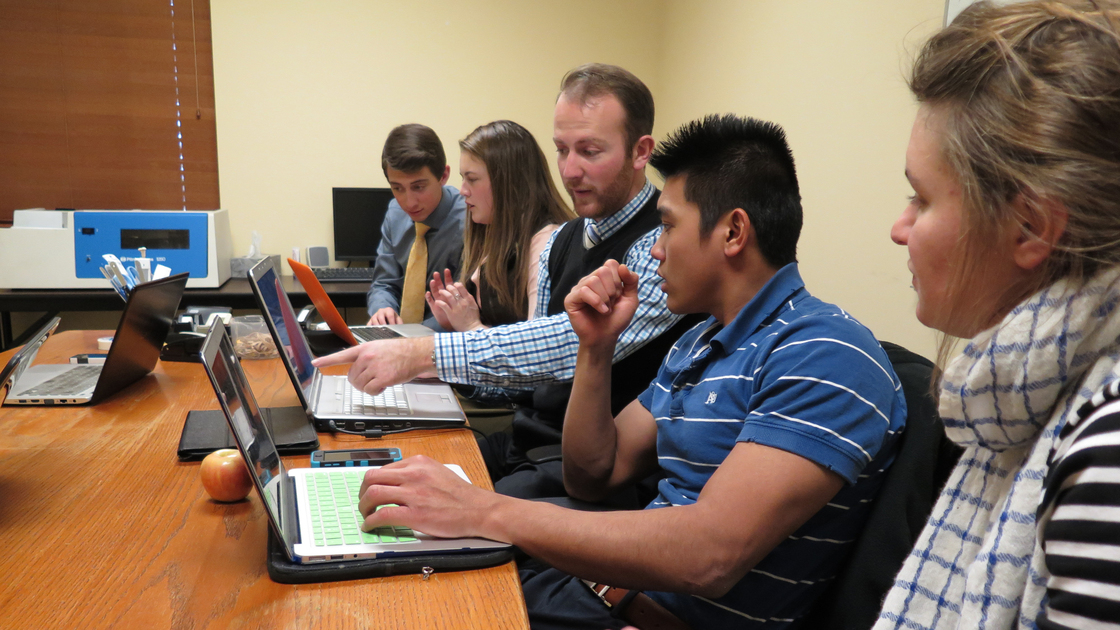EDMOND—Today, a handful of students gathered in the mail opening room of the Hall of Administration on the campus of Herbert W. Armstrong College. They were armed with laptops and Bibles, and their purpose was not just to absorb a fund of knowledge, but to build one.
This is the Chronology of Bible Prophecy independent study course at Herbert W. Armstrong College. The class meets every Friday, when students wade through rivers of dates and events, sorting, organizing, checking, cross-checking and building a detailed joint project, one date at a time.
Philadelphia Church of God staff member Edwin Trebels, a graduate of the college, has led the study since it began on Jan. 16, 2014. “We were hoping to create a timeline and research folder which would further insight into the prophecies of God and how they tie in with historical events,” he said. “To keep all the prophecies straight in your mind is quite task, and I believe that putting them in chronological order provides a good framework for study.”
Throughout its five semesters, the class size has ranged from two to five students.
Currently, the students participating in the study include Kassandra Verbout (freshman), Zac Bush (junior), Justin Goodearl (senior), Anya Trietsch (senior) and Joel Hudson-Stewart (senior).
As the students locate and check events from history and from Bible prophecy, Trebels further organizes, categorizes and records the research using Aeon Timeline software. He uses his research from Imperial Academy Bible and history classes to corroborate dates and seeks out further clarification from pcg ministers when needed.
The basic purpose of Chronology of Bible Prophecy is to date the original prophecies using Church literature and reliable secular records, and to date the first and sometimes second fulfillments of the prophecy. Many prophecies are classed as “date unknown” or “future fulfillment.” But since an estimated one third of the Bible consists of prophecy, many prophecies can be dated or narrowed down to a range of dates.
“Understanding the context of each of these dates really does enrich our understanding of each prophecy and helps us remember why God gives us prophecy in the first place,” Trebels said.
Taking Luke 21:20 as an example, a student is assigned to research an approximate date for when Christ spoke this prophecy and when Luke wrote his book. The student documents the source material he used, then searches through literature by Herbert W. Armstrong and other former Worldwide Church of God and pcg writers, then places a date on the first fulfillment of this prophecy (A.D. 70 when the armies of Titus took Jerusalem, in this example). He then notes that the Bible and the literature states there will be a second fulfillment, date unknown.
Hundreds of such events, dates and sources are connected together visually on the Aeon timeline.
The fourfold purpose of the class is taken from several statements from Herbert W. Armstrong College chancellor and Philadelphia Church of God Pastor General Gerald Flurry:
1) To give the greatest proof that God exists
(Key of David program, “Jonah—A Sign of When Christ Comes Again”)
2) To show that God rules
(The Royal Book of Revelation, page 5)
3) To provide one of the strongest proofs of the Bible
(Isaiah’s End-Time Vision, page 105)
4) To build our faith in order to sacrifice and endure to the end
(John’s Gospel—The Love of God)
Armstrong junior Maree Tolis, who took the class in a previous semester, said, “I gained a deeper understanding of how many specific and detailed prophecies there are in the Bible—and the awesome way God has promised to keep them all and has always kept his word. We can definitely trust in God.”
“I think the greatest benefit of this class is having the opportunity to be around that much information at once. You are in the presence of so much information about the chronology of world history, yet you are looking at it through the focused lens of God’s Work through His Church,” said junior Jordan Ellis, another former Chronology of Bible Prophecy student. “It’s a privilege to just simply be in that environment.”
“I feel like the extra study of these prophecies is going to greatly enhance my experience here at college, especially as a freshman,” said Verbout. “I’m excited to see the end product because it’s going to reveal how vast, yet detailed, God’s plan is through prophecies.”
The study currently has already assisted with research for multiple published articles as well as solving a few discrepancies when different dates were used for the same events.
The project for the students currently taking the study is to finalize the timeline into an aesthetically pleasing, practical research product for potential users in the Editorial department or among Imperial and Armstrong faculty. This involves a meticulous process of checking and double-checking.
With almost 1,000 dates currently on the timeline program, students are immersed in dates and prophecies that solidify the veracity of the Bible.
“When you start seeing the correlation between all the different historical events and God’s inspired prophecies, it is mind-blowing to see how directly involved God has been throughout mankind’s history,” Trebels said. “History is really best studied through the prophetic lens, because God makes it clear which historical events are most important.”
